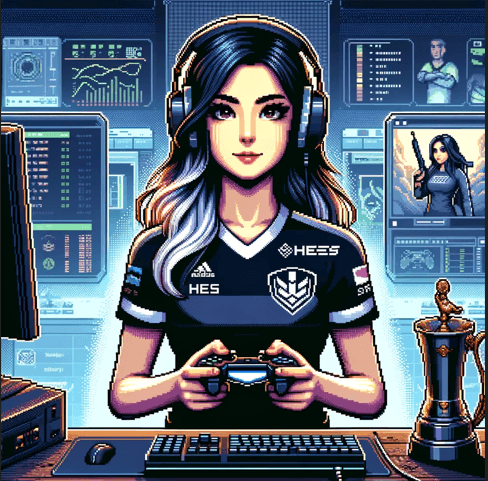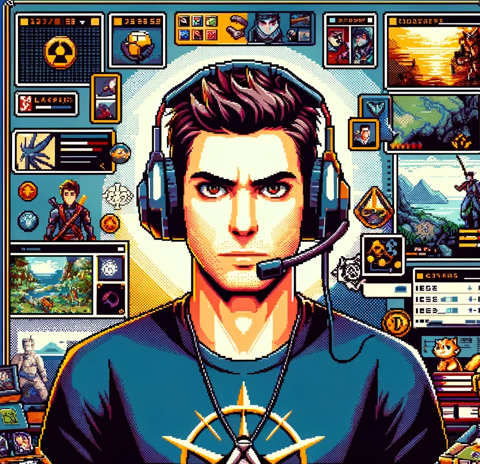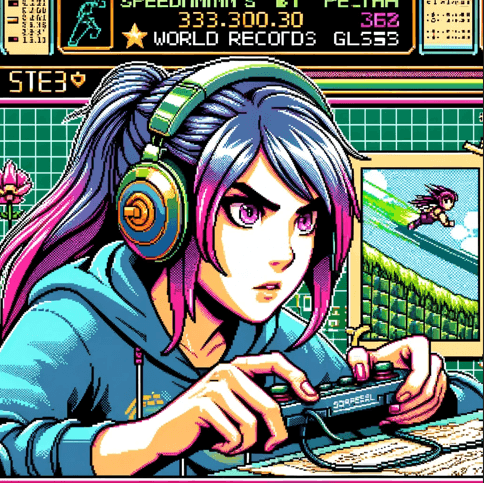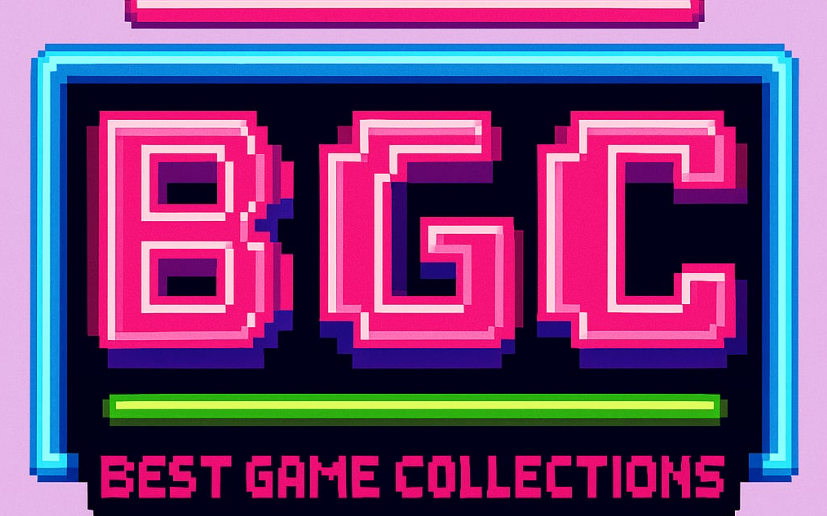 Hey everyone, let’s talk about The Witch’s House MV, made by Fummy and released by DANGEN Entertainment on March 6, 2025, for PC and Nintendo Switch. First, let’s dive into what makes this remaster stand out: it uses the RPG Maker MV engine to deliver smooth pixel-art graphics. Additionally, its tricky puzzles and instant-death traps really test your skill, and the game gives you over 30 fixed save spots. As a result, you’ll need to think carefully at every step, and the many hidden secrets keep you exploring, Although some jumps in difficulty can feel sudden.
Hey everyone, let’s talk about The Witch’s House MV, made by Fummy and released by DANGEN Entertainment on March 6, 2025, for PC and Nintendo Switch. First, let’s dive into what makes this remaster stand out: it uses the RPG Maker MV engine to deliver smooth pixel-art graphics. Additionally, its tricky puzzles and instant-death traps really test your skill, and the game gives you over 30 fixed save spots. As a result, you’ll need to think carefully at every step, and the many hidden secrets keep you exploring, Although some jumps in difficulty can feel sudden.
 Completely agree. In fact, I’ve hunted down all 20 collectibles, heard extra dialogue, and unlocked three endings. Interestingly, Fummy hid riddles and surprises around every corner of the haunted house. Meanwhile, the two extra difficulty modes, “Accessible” and “True Ending,” draw mixed opinions, but they do let you see everything the game offers. Therefore, if you love finding every secret, each trap and hidden room feels like a reward.
Completely agree. In fact, I’ve hunted down all 20 collectibles, heard extra dialogue, and unlocked three endings. Interestingly, Fummy hid riddles and surprises around every corner of the haunted house. Meanwhile, the two extra difficulty modes, “Accessible” and “True Ending,” draw mixed opinions, but they do let you see everything the game offers. Therefore, if you love finding every secret, each trap and hidden room feels like a reward.
 Although I love open-world mystery games, even though it’s set in a tight space, this title gives a big sense of discovery. Additionally, the story and hidden lore remind me of classics like Ib and Ao Oni. Also, each corridor and trap feels alive, thanks to charming 16-bit-style art. In about an hour and a half, you’ll see a lot of content.
Although I love open-world mystery games, even though it’s set in a tight space, this title gives a big sense of discovery. Additionally, the story and hidden lore remind me of classics like Ib and Ao Oni. Also, each corridor and trap feels alive, thanks to charming 16-bit-style art. In about an hour and a half, you’ll see a lot of content.
 Right on. Specifically, I optimized my runs through the mansion’s maze-like layout, experimenting with speedrun strategies around its fixed save points and sudden-death pitfalls. Additionally, I discovered quirky item-use tricks, such as swapping the Silver Key with environmental objects mid-run, which shaved precious seconds off my record. Ultimately, the game challenges both careful planning and lightning-fast reflexes, and I appreciated learning from each trial and error, even when hazards wreak havoc on my times.
Right on. Specifically, I optimized my runs through the mansion’s maze-like layout, experimenting with speedrun strategies around its fixed save points and sudden-death pitfalls. Additionally, I discovered quirky item-use tricks, such as swapping the Silver Key with environmental objects mid-run, which shaved precious seconds off my record. Ultimately, the game challenges both careful planning and lightning-fast reflexes, and I appreciated learning from each trial and error, even when hazards wreak havoc on my times.
 Let’s deep dive into gameplay mechanics. The Witch’s House MV has a unique control system that demands careful movement. Every item feels deliberate, especially when solving puzzles that mix environmental cues with real-time decision making. It reminds me of other classic horror RPGs, but it adds modern twists that heighten tension. The fixed save points with the talking black cat serve as a fun, sometimes eerie guide through gameplay.
Let’s deep dive into gameplay mechanics. The Witch’s House MV has a unique control system that demands careful movement. Every item feels deliberate, especially when solving puzzles that mix environmental cues with real-time decision making. It reminds me of other classic horror RPGs, but it adds modern twists that heighten tension. The fixed save points with the talking black cat serve as a fun, sometimes eerie guide through gameplay.
 I appreciate when games use mechanics that support thorough exploration. The creative puzzles here make players think hard about items and their purpose. I noted that each trap is supported by the environment’s layout. Although some areas feel punishingly sudden, they encourage thoughtful exploration. Fummy’s five-times-over effort for remastered visuals shows in the detailed map tiles and sprite art. That effort translates into a game packed with secrets that reward persistence.
I appreciate when games use mechanics that support thorough exploration. The creative puzzles here make players think hard about items and their purpose. I noted that each trap is supported by the environment’s layout. Although some areas feel punishingly sudden, they encourage thoughtful exploration. Fummy’s five-times-over effort for remastered visuals shows in the detailed map tiles and sprite art. That effort translates into a game packed with secrets that reward persistence.
 Story and narrative wise, the game pulls you into a dark world. Viola’s tragic journey is filled with unexpected turns and subtle hints at hidden lore. Dialogue with characters like the mysterious black cat deepens immersion. Fummy’s intentions are clear: to reframe horror through tight narrative pacing and deliberate jump scares. The narrative pacing can feel brisk but remains engaging and emotional, appealing to players who value storytelling.
Story and narrative wise, the game pulls you into a dark world. Viola’s tragic journey is filled with unexpected turns and subtle hints at hidden lore. Dialogue with characters like the mysterious black cat deepens immersion. Fummy’s intentions are clear: to reframe horror through tight narrative pacing and deliberate jump scares. The narrative pacing can feel brisk but remains engaging and emotional, appealing to players who value storytelling.
 I’d add that the narrative also influences my speedrunning runs. Quick dialogue exchanges may slow you down but add depth and a twist of thrill. The lore is disseminated slowly through clues and unlockable events on higher difficulties. It makes replay runs feel fresh because each complete playthrough uncovers new story fragments and challenges.
I’d add that the narrative also influences my speedrunning runs. Quick dialogue exchanges may slow you down but add depth and a twist of thrill. The lore is disseminated slowly through clues and unlockable events on higher difficulties. It makes replay runs feel fresh because each complete playthrough uncovers new story fragments and challenges.
 Now on to visuals and graphics. The remastered pixel art is sharp and atmospheric. Fummy reimagined every character sprite and map tile which builds a beautifully terrifying experience. The game engine runs smoothly on different platforms and the art style reminds me of 16-bit classics. The color palettes and minimalist animations add a timeless quality that enhances the horror mood.
Now on to visuals and graphics. The remastered pixel art is sharp and atmospheric. Fummy reimagined every character sprite and map tile which builds a beautifully terrifying experience. The game engine runs smoothly on different platforms and the art style reminds me of 16-bit classics. The color palettes and minimalist animations add a timeless quality that enhances the horror mood.
 Absolutely. I spent hours examining environmental details and hidden motifs. The detailed art encourages exploration and rewards observation. Although the game is short, its visuals add layers of complexity that make replays rewarding. I often compare this remaster to older horror titles that used visuals to create suspense. Fummy and DANGEN Entertainment have done a commendable job.
Absolutely. I spent hours examining environmental details and hidden motifs. The detailed art encourages exploration and rewards observation. Although the game is short, its visuals add layers of complexity that make replays rewarding. I often compare this remaster to older horror titles that used visuals to create suspense. Fummy and DANGEN Entertainment have done a commendable job.
 The sound design also deserves praise. The eerie ambient tracks and sudden sound effects build tension in every corner. I loved the subtle soundtrack cues that hint at upcoming traps or story twists. The sound effects integrate perfectly with environmental interactions, adding to the overall suspense. The audio truly complements the game’s artistic direction.
The sound design also deserves praise. The eerie ambient tracks and sudden sound effects build tension in every corner. I loved the subtle soundtrack cues that hint at upcoming traps or story twists. The sound effects integrate perfectly with environmental interactions, adding to the overall suspense. The audio truly complements the game’s artistic direction.
 The music and sound cues gave me split-second reactions during runs. The arrangement is atmospheric and never overpowers gameplay. Instead, it builds perfect tension during puzzle sections. I also noticed that background tracks change tone in critical moments, which really enhances the speedrunning challenge.
The music and sound cues gave me split-second reactions during runs. The arrangement is atmospheric and never overpowers gameplay. Instead, it builds perfect tension during puzzle sections. I also noticed that background tracks change tone in critical moments, which really enhances the speedrunning challenge.
 Regarding characters, Viola stands out with her mystery and vulnerability. Secondary figures like the talking black cat add quirky charm and pivotal hints. The character arcs are simple yet effective. Their sparse dialogue contains hints for those who examine every detail. The character design is respectful of the genre’s tradition while adding modern twists.
Regarding characters, Viola stands out with her mystery and vulnerability. Secondary figures like the talking black cat add quirky charm and pivotal hints. The character arcs are simple yet effective. Their sparse dialogue contains hints for those who examine every detail. The character design is respectful of the genre’s tradition while adding modern twists.
 I appreciate that every character seems to carry a hidden backstory. Even minor characters have nuances that connect to the lore. The game supports diverse puzzle solutions which makes them even more accessible to various play styles. The subtle representation adds inclusivity without straying from the game’s harsh narrative.
I appreciate that every character seems to carry a hidden backstory. Even minor characters have nuances that connect to the lore. The game supports diverse puzzle solutions which makes them even more accessible to various play styles. The subtle representation adds inclusivity without straying from the game’s harsh narrative.
 The characters feel genuine, even in a pixel-art game. Their development is connected strongly to the environment and lore. It feels like every interaction is a thread in the larger tapestry. I appreciate how the narrative provides context even during brief encounters.
The characters feel genuine, even in a pixel-art game. Their development is connected strongly to the environment and lore. It feels like every interaction is a thread in the larger tapestry. I appreciate how the narrative provides context even during brief encounters.
 The character design also influences gameplay strategy. Knowing each character’s role helps in devising quicker routes through the puzzle sections. Their minimal dialogues provide hints that are key for both narrative depth and efficient gameplay.
The character design also influences gameplay strategy. Knowing each character’s role helps in devising quicker routes through the puzzle sections. Their minimal dialogues provide hints that are key for both narrative depth and efficient gameplay.
 Now, let’s discuss challenge level. The balance of puzzles, environmental hazards, and sudden-death traps defines the game. Many users noted the unexpected twists, seemingly meaning a 1.5-hour playthrough is intense. Some feel the difficulty spikes are abrupt. Yet, DANGEN Entertainment offers two difficulty modes to accommodate both casual explorers and hardcore gamers.
Now, let’s discuss challenge level. The balance of puzzles, environmental hazards, and sudden-death traps defines the game. Many users noted the unexpected twists, seemingly meaning a 1.5-hour playthrough is intense. Some feel the difficulty spikes are abrupt. Yet, DANGEN Entertainment offers two difficulty modes to accommodate both casual explorers and hardcore gamers.
 Every trap is a challenge that requires deliberate thought. While some reviews mention sadness and sudden difficulties, those who love the depth of puzzle-solving find these moments rewarding. I see each trap as part of an elaborate design that encourages multiple playthroughs.
Every trap is a challenge that requires deliberate thought. While some reviews mention sadness and sudden difficulties, those who love the depth of puzzle-solving find these moments rewarding. I see each trap as part of an elaborate design that encourages multiple playthroughs.
 The layered challenges and hidden lore create a balanced experience. Though the game can be punishing, its difficulty modes let players choose their risk. It compares well with similar horror puzzlers like Ib, appealing to fans of intricate puzzles and narratives.
The layered challenges and hidden lore create a balanced experience. Though the game can be punishing, its difficulty modes let players choose their risk. It compares well with similar horror puzzlers like Ib, appealing to fans of intricate puzzles and narratives.
 For speedrunners, the challenge lies in mastering quick reflex decisions. The mix of puzzles and sudden death moments adds a thrilling edge. I appreciate how it forces players to adapt constantly, making each run a new test of skill.
For speedrunners, the challenge lies in mastering quick reflex decisions. The mix of puzzles and sudden death moments adds a thrilling edge. I appreciate how it forces players to adapt constantly, making each run a new test of skill.
 Finally, I want to touch on replay value. I love games that reward multiple playthroughs. The Witch’s House MV hides extra story bits and unlockable difficulties that encourage replay. There are hidden endings and collectibles that compare favorably to games like Ao Oni and classic horror RPGs.
Finally, I want to touch on replay value. I love games that reward multiple playthroughs. The Witch’s House MV hides extra story bits and unlockable difficulties that encourage replay. There are hidden endings and collectibles that compare favorably to games like Ao Oni and classic horror RPGs.
 Replayability is strong here. Every minute reveals new lore or secret challenges. The new difficulty mode and branching puzzles make every playthrough feel unique. It holds more surprises on each return trip, making it a treasure trove for completionists.
Replayability is strong here. Every minute reveals new lore or secret challenges. The new difficulty mode and branching puzzles make every playthrough feel unique. It holds more surprises on each return trip, making it a treasure trove for completionists.
 Every run deepens my appreciation of the lore. The branching dialogue and hidden events invite multiple adventures. Although it is a short game, each replay feels enriched by new discoveries.
Every run deepens my appreciation of the lore. The branching dialogue and hidden events invite multiple adventures. Although it is a short game, each replay feels enriched by new discoveries.
 And from my perspective, every run is a chance to improve my time while uncovering new shortcuts. The design keeps runs engaging and full of learning opportunities. The game stands tall among its pixel-art horror peers.
And from my perspective, every run is a chance to improve my time while uncovering new shortcuts. The design keeps runs engaging and full of learning opportunities. The game stands tall among its pixel-art horror peers.
 To wrap up, The Witch’s House MV stands out with its unique blend of horror, puzzles, and replay value. Its remastered graphics and atmospheric sound design set new standards. Fans of detailed exploration, engaging narratives, and speedrun challenges will find reasons to return.
To wrap up, The Witch’s House MV stands out with its unique blend of horror, puzzles, and replay value. Its remastered graphics and atmospheric sound design set new standards. Fans of detailed exploration, engaging narratives, and speedrun challenges will find reasons to return.
 I recommend this game to those who love discovery and meticulously exploring every detail. I find that its challenge and hidden secrets add rich layers to the experience.
I recommend this game to those who love discovery and meticulously exploring every detail. I find that its challenge and hidden secrets add rich layers to the experience.
 Its immersive storyline and classic horror vibes work perfectly for those who relish mystery and adventure. The blend of past and present design makes it worthwhile.
Its immersive storyline and classic horror vibes work perfectly for those who relish mystery and adventure. The blend of past and present design makes it worthwhile.
 I commend its design for speedrunners looking for a challenging and fast-paced puzzle hunt. It’s a unique addition to the indie horror genre.
I commend its design for speedrunners looking for a challenging and fast-paced puzzle hunt. It’s a unique addition to the indie horror genre.
If you enjoy The Witch’s House MV, consider playing these: Ib, a pixel-art horror puzzle where you explore surreal art and eerie environments. Ao Oni, a classic horror adventure with intense chases and puzzle elements. Mad Father, a dark RPG with twisted narratives and challenging puzzles. Misao, a horror mystery filled with unpredictable traps and hidden storytelling. Yume Nikki, a surreal, exploratory experience with dreamlike puzzles and atmosphere.
Each game presents its own twist on horror and puzzles while delivering engaging, replayable content.
